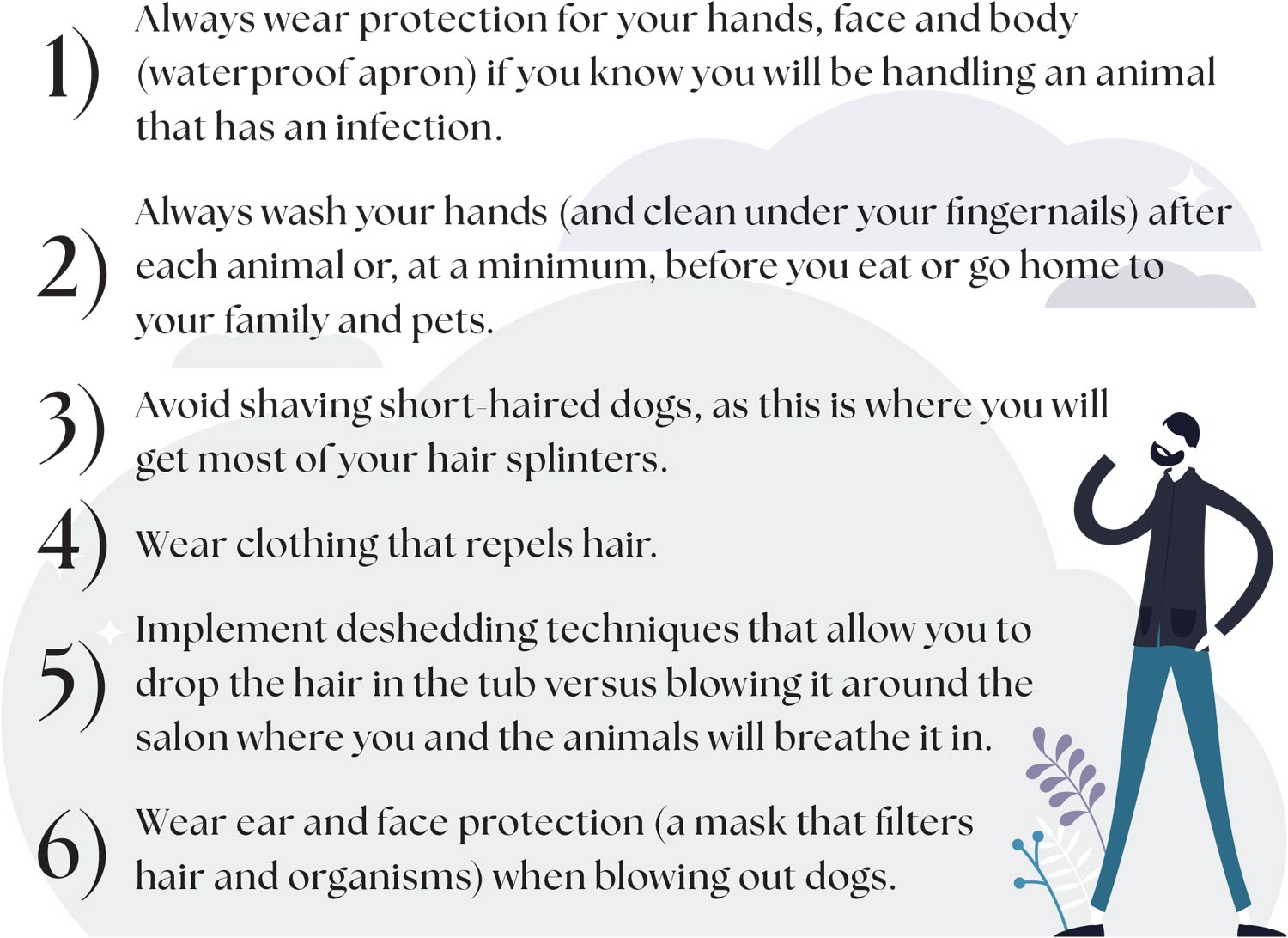
by Dr. Cliff Faver
 hen we decided to go into the pet industry, we knew that in dealing with animals there would be a certain amount of risk involved with handling scared or potentially aggressive individuals. We also know that back and wrist problems were common among groomers. What we don’t think about, though, are the hazards that are not quite as obvious, but frequently just as bad (if not worse) than a bite or arthritis.
hen we decided to go into the pet industry, we knew that in dealing with animals there would be a certain amount of risk involved with handling scared or potentially aggressive individuals. We also know that back and wrist problems were common among groomers. What we don’t think about, though, are the hazards that are not quite as obvious, but frequently just as bad (if not worse) than a bite or arthritis.
One area of hazards we see with handling animals are those that have infections of the skin, ears, mouth, urinary tract, anal glands, etc. We often take precautions to prevent exposure if we know they are present, but we have to realize not all infections are apparent though. Even if they are, we sometimes fail to assess or consider the repercussions we could face.
Commonly, we are taught (or assume) that the shampoo will protect us in this process. Shampoo is designed to clean, and unless it is specifically designed to kill bacteria/fungus, it does not protect against infection. We do have the benefit that it may dilute the sources of infection in the bathing process, which gives us some coverage, but it doesn’t actually kill it, leaving us vulnerable.
Dealing with anal glands and washing the anal area is one instance where we should always wear protection. Fecal material is around 90% bacteria, and not always good bacteria. Did you know that Salmonella is one of the most common reasons for the recall of dog foods and reasons given to avoid raw diets? A dog fed a diet high in Salmonella will often shed it in their fecal material. Salmonella in humans often leads to severe bloody diarrhea and can be very deadly, especially in young children, due to blood loss and dehydration.
Parasites are another hazard associated with fecal material. Humans are not the usual hosts for most of these parasites, so many times they will take very different pathways in the human body. Roundworms, for example, are one of the most common parasites of our pets (also raccoons). These same parasites that usually cause digestive and respiratory issues in pets, when introduced to the human body, can end up in the blood vessels behind the eyes and in the brain, causing blindness and even severe neurological issues. This is especially scary in the developing brain of young children.


If you love what you do and want to do it for the rest of your life, you must work smart so that one or more of these hazards doesn’t shorten your career path.
Infection and parasites are not the only hazards groomers face. They are also confronted with tiny hair slivers that tend to penetrate the skin, causing irritation and tissue abscesses. You will commonly see them between the fingers, between the toes (if not wearing closed-toed shoes) and any area of tight clothing. These are very small and can be next to impossible to find once under the skin. This has a higher incidence of occurring when short-haired dogs are shaved because of the trimmed hair’s stiffness and short length.
Probably one of the more common and most debilitating issues groomers deal with is Groomer’s Lung. It is a combination of breathing in hair slivers, bacteria, fungi, dead skin cells and probably even an occasional parasite. As young groomers, many do not worry about it affecting them because they think about bad things with a “that’s not going to happen to me” mindset. In addition, taking precautions is a pain and takes time and money, so many skip or ignore those steps. But before you go down that road, talk to some older/wiser groomers and let them educate you on what your life will look like if you don’t take this seriously. Groomer’s Lung is real, and there’s a high possibility you will deal with it at one level or another.
If you love what you do and want to do it for the rest of your life, you must work smart so that one or more of these hazards doesn’t shorten your career path. The chances of it being a problem in some cases may be slim, but even if it is a million to one odds, if you get it, it will be a 100% occurrence for you!
Dr. Cliff Faver graduated with a BS in Biology/BA in Chemistry before getting a Veterinary degree in 1987. He is the past owner of Animal Health Services in Cave Creek, Arizona and now the US distributor for Iv San Bernard products, teaches the ISB Pet Aesthetician Certification program, and speaks internationally on hair and skin. His passion is to merge groomers and veterinarians to aid in helping and healing pets. He is also a member of AVMA, AAHA, AZVMA, Board member with Burbank Kennel Club, and has served on Novartis Lead Committee, Hill’s International Global Veterinary Board, and a Veterinary Management Group.

